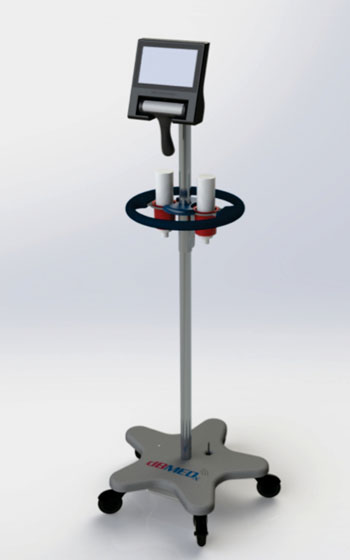Compact Ultrasound Scanner Measures Bladder Volume
By HospiMedica International staff writers
Posted on 22 Jan 2015
An automatic bladder volume measurement device provides rapid, objective information on the necessity for a urinary catheter.Posted on 22 Jan 2015
The BBS Revolution automated bladder volume measurement device is an ultrasound based system that requires only a short sweep across the abdomen to automatically calculate bladder volume and display the reading on a screen. The whole process takes just minutes to complete, and can be performed by staff that have not necessarily been trained in using ultrasound equipment. The underlying technology uses a proprietary algorithm to produce a true three dimensional (3D) volume dataset, using multiple b-mode slices.

Image: The BBS Revolution automated bladder volume measurement device (Photo courtesy of dBMEDx).
The BBS Revolution is battery powered and pole mounted, with a palm-sized, compact probe that is inductively charged when docked in the console. The probe performs image collection and analysis automatically, transferring the results wirelessly via integrated Bluetooth wireless radio to a wide range of potential display platforms and mobile devices. The BBS Revolution automated bladder volume measurement device is a product of dBMEDx (Denver, CO, USA), and has been approved by the US Food and Drug Administration (FDA).
“The initial use will be to check the volume of urine in a patient’s bladder. When you’re in the hospital, you typically have to go to the bathroom before you can leave. If that doesn’t happen, it may be that you need to drink more water or there might be a true medical problem,” said David Shine, CEO of dBMEDx. “The real value with this is that you don’t have to put a catheter in someone to find out. Medicare is not paying for these infections if a patient acquires the infection during a hospital stay, so hospitals are very motivated not to have these infections occur.”
Bladder volume measurement is a well-established metric used in the diagnosis and treatment of a wide range of medical conditions, including urinary tract infections (UTI). It is a critical component of a comprehensive catheter-associated urinary tract infection (CAUTI) prevention program, an area of intense focus for hospitals given recent Medicare penalties for hospitals with high CAUTI rates, which include reducing payments by one percent for hospitals with a high number of hospital acquired conditions (HACs).
Related Links:
dBMEDx














